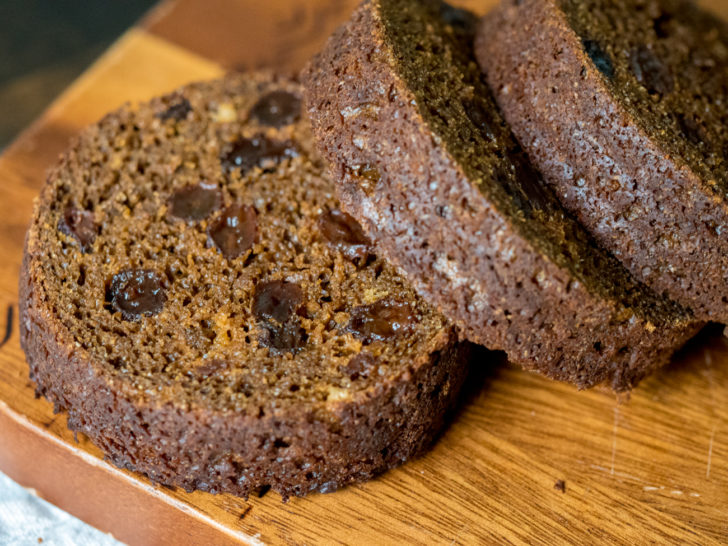 Pin it
Pin it
This classic Boston Brown Bread recipe brings authentic New England tradition to your table with its rich molasses flavor and moist, dense texture. The combination of wheat and all-purpose flours creates the perfect canvas for sweet raisins, while the buttermilk keeps everything tender. Whether served alongside baked beans for a traditional Saturday night supper or toasted for breakfast, this versatile bread delivers warmth and comfort with every slice.
I discovered this recipe during a deep dive into traditional New England cooking and have made it countless times since. My family especially requests it during the colder months when the aroma of molasses and warm bread makes our kitchen the coziest place in the house.
- Wheat flour: Provides the hearty base and authentic texture traditional to Boston Brown Bread
- All purpose flour: Balances the density and helps create the perfect crumb
- Buttermilk: Delivers tenderness and a subtle tang that complements the sweetness
- Molasses: Gives this bread its signature dark color and rich distinctive flavor
- Raisins: Add bursts of natural sweetness and traditional texture
- Baking soda and baking powder: Work together for proper rise despite the dense ingredients
- Boiling water: Plumps the raisins making them juicy and ensuring they distribute evenly
Step-by-Step Instructions
- Prep Your Equipment:
- Thoroughly clean and dry coffee cans if using them for the authentic cylindrical shape. Spray generously with nonstick spray making sure to coat the bottoms completely. The traditional shape makes for beautiful presentation but a standard loaf pan works perfectly too.
- Plump The Raisins:
- Place your raisins in a bowl and cover them completely with boiling water. Let them soak for a full 10 minutes which transforms them from dry and chewy to plump and juicy. This step ensures moist raisins throughout your bread and better flavor distribution.
- Mix Dry Ingredients:
- Combine the wheat flour all purpose flour sugar baking powder and salt in a large bowl whisking thoroughly to eliminate any lumps. This even distribution of dry ingredients is crucial for consistent texture throughout your bread.
- Prepare Wet Ingredients:
- In a separate bowl dissolve the baking soda in buttermilk whisking until completely incorporated. Then stir in the molasses until you have a smooth mixture. Keeping these ingredients separate until the last moment helps activate the leaveners properly.
- Combine Everything:
- Gently fold the wet ingredients into the dry ingredients mixing just until incorporated. Overmixing will develop too much gluten making your bread tough. Fold in the plumped raisins ensuring they're evenly distributed throughout the batter.
- Fill Containers:
- Pour your batter into prepared cans filling only halfway to allow room for proper rising. Tap the cans firmly on the counter several times to release any air bubbles which could create holes in your finished bread.
- Baking Technique:
- Place your cans on a baking sheet for stability in the oven. The optional second baking sheet on top helps control the rise creating the traditional flat top. Bake at 350°F for exactly 50 minutes before removing the top sheet.
- Final Baking:
- Bake for an additional 10 minutes uncovered to allow the tops to brown properly. Test for doneness by inserting a toothpick into the center which should come out clean or with just a few moist crumbs.
- Unmolding:
- Let the bread cool in the cans for 10 minutes before running a knife around the edges to loosen. Gently remove from cans and transfer to a wire rack to cool completely allowing the texture to set properly.
Molasses is truly the star ingredient in this recipe. I always opt for unsulphured molasses for its smoother flavor profile. During my childhood our neighbor Mrs. Sullivan would bring over Boston Brown Bread still warm from the oven whenever it snowed. That memory of comfort and community is baked into this recipe for me.
Serving Suggestions
Boston Brown Bread has traditional pairings that showcase its unique flavor profile. Serve warm slices slathered with salted butter alongside baked beans for an authentic New England Saturday night supper. For breakfast toast slices and top with cream cheese or ricotta with a drizzle of honey. The slight sweetness and hearty texture also pair wonderfully with sharp cheddar cheese and thinly sliced apples for an afternoon snack platter.
Historical Background
This bread dates back to colonial times when New England cooks needed to create breads without ovens. The original versions were steamed in cylindrical molds often cans hence the traditional shape. The ingredients reflect what was readily available to early settlers wheat flour molasses and dried fruits. Traditionally served with baked beans on Saturday nights this pairing became known as Boston Baked Beans and Brown Bread a combination that sustained generations of New Englanders.
Storage Tips
Boston Brown Bread actually improves with a day of rest as the flavors meld and deepen. Store completely cooled bread tightly wrapped in plastic wrap then aluminum foil at room temperature for up to 3 days. For longer storage freeze individual slices with parchment paper between them for up to 3 months. Thaw at room temperature or toast from frozen for a quick treat. The bread can be refreshed by warming in a 300°F oven for about 10 minutes if it begins to dry out.
Frequently Asked Questions
- → What makes Boston Brown Bread unique?
Boston Brown Bread is known for its moist, dense texture, slight sweetness from molasses and raisins, and its traditional cylindrical shape if baked in cans.
- → Can I use regular loaf pans instead of cans?
Yes, you can use a 9x5-inch greased loaf pan if you don't have cans. The result will be slightly different in shape but equally delicious.
- → How should I serve Boston Brown Bread?
It’s best served warm with butter or cream cheese. It pairs beautifully with savory stews, soups, or as part of a brunch spread.
- → Can I use a different flour instead of wheat flour?
Wheat flour is traditional for this recipe, but you can experiment with alternatives like rye or spelt. Keep in mind this may alter the texture and flavor.
- → How long does Boston Brown Bread last?
Stored in an airtight container, it can last 3-4 days at room temperature or up to a week in the refrigerator.
- → What can I substitute for buttermilk?
You can make a substitute by adding 1 tablespoon of lemon juice or vinegar to a cup of milk and letting it sit for 5 minutes before use.
